Turkish crescent
A Turkish crescent (a smaller version is called a çevgen[1] or çağana[2][3][4] (Tr.), Turkish jingle, Jingling Johnny,[4] Schellenbaum[5] (Ger.), chapeau chinois[6] or pavillon chinois (Fr.)), is a percussion instrument traditionally used by military bands internationally. In some contexts it also serves as a battle trophy or object of veneration.
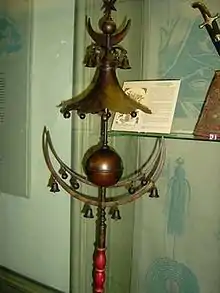
Description
The instrument, usually 2 to 2.5 m (6 ft 7 in to 8 ft 2 in) long, consists of an upright wooden pole topped with a conical brass ornament and having crescent shaped crosspieces, also of brass. Numerous bells are attached to the crosspieces and elsewhere on the instrument. Often two horsetail plumes of different colors are suspended from one of the crescents; occasionally they are red-tipped, symbolic of the battlefield. There is no standard configuration for the instrument, and of the many preserved in museums, hardly two are alike.[7]
The instrument is held vertically and when played is either shaken up and down or twisted.[8] Sometimes there is a geared crank mechanism for rotating it.[9]
Today the instrument is prominent in the marching bands of the German Bundeswehr, the French Foreign Legion, the Russian Armed Forces, the Armed Forces of Chile, the Armed Forces of Bolivia and in Ottoman military bands. Some folk music features similar instruments based on a wooden staff with jingling attachments. A notable folk example is the Australian "lagerphone", made by nailing crown-seal bottle-caps, from beer bottles, onto a wooden broomstick handle, and used to provide a percussive beat for a folk song or bush dance.
During its existence, the Soviet Union produced variant forms of the instrument for military bands, with red artificial plumes and the red star finial.
Non-musical aspects
Turkish crescents had symbolic value for the military units that used them. The 88th Regiment of Foot (Connaught Rangers) famously captured one at the Battle of Salamanca in 1812. It became an object of pride and veneration at the regiment's ceremonial parades.[10]
In the early 20th century, Turkish crescents were used in processions honoring important dignitaries. They were skillfully twirled by dignified performers, much as batons are handled today by drum majors.[11] This aspect survives today in the use of Turkish crescents as mostly symbolic objects in military marching bands. This can be clearly seen in the videos in the External links section at the end of this article.
History
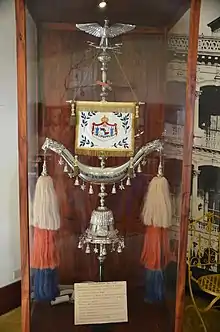
The instrument possibly has antecedents in Central Asian tengrist staffs. Similar instruments occur in ancient Chinese music, perhaps diffused from the same Central Asian (Turkic) sources.[12]
Europeans knew of it in the 16th century. In the 18th century, it was part of the Turkish Janissary bands that were the source of much interest in Europe, and in the 19th century, it was widely used in European military bands. It was abandoned by the British in the mid-19th century but survives today, in an altered form, in Germany[8] and in the Netherlands, plus in two military bands in France (the French Foreign Legion and the 1st Spahi Regiment). It is also found in the military bands of the Russian Federation, Ukraine, Belarus, Azerbaijan, Kazakhstan, Chile, Peru, Bolivia and Brazil (examples are in the Brazilian Marine Pipes, Drum and Bugle Corps and the Band of the 1st Guards Cavalry Regiment "Independence Dragoons"). Its presence in the bands of Chile, Brazil and Bolivia is due to the Prussian military influences which arrived in these countries during the late 19th to early 20th centuries.
Its heyday in Europe was from the mid-18th to mid-19th century, when it was commonly played by elaborately dressed black Africans, who made all manner of contortions while playing. Some of these gestures survive today, in the stick twirling by bass and tenor drummers. An aspect of the elaborate costumes survives in the leopard skin apron worn by bass drummers in British military bands;[13] however the use of the "Jingling Johnny" was discontinued in the British Army in 1837.[14]
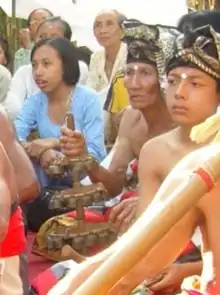
In 1881, the German Emperor William I presented a Turkish crescent to King David Kalākaua on the occasion of the King's visit to Berlin during his trip around the world[15] bearing the inscription "no ka hoomanao ana ia Berlin" (to commemorate Berlin),[16] which was then used by the Royal Hawaiian Band.
In the mid-19th century this instrument was replaced in most bands by the glockenspiel, which was carried similarly but could be played musically.[7]
Argentina
Known as the "Chinesco", the instrument was used by Afro-Argentinians in the 19th century. Descriptions of the instrument describe the masacalla, an ethnic instrument. A painting by Martin Boneo and a news clipping from 1899 show an instrument held on a long pole, with horsetails, and either a pointed top like a Chinese hat, or a crescent.
Java and Bali
The instrument has also been known in Java under the names genta (Hindu-Javanese), klinting, byong or Kembang delima (pomegranate blossom), and in Bali as gentorag. The Javanese instruments lack the crescent or hat, but have "a central wooden spindle" with the bells suspended at different levels on crosses of wood or metal. Bells can also be suspended on wheels stacked above each other, largest on the bottom to tallest on the top. The wheel is mounted to that its rim is not up and down like a car rim, but horizontal to the ground.[17]
 Cevgen player in an Ottoman military band
Cevgen player in an Ottoman military band Chapeau chinois of the French Foreign Legion.
Chapeau chinois of the French Foreign Legion. Schellenbaum of the German Bundeswehr
Schellenbaum of the German Bundeswehr An officer of the Peruvian 1st Cavalry Regiment "Glorious Hussars of Junín" carrying a Turkish crescent
An officer of the Peruvian 1st Cavalry Regiment "Glorious Hussars of Junín" carrying a Turkish crescent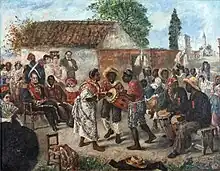 Argentina, depiction of early 19th century. A masacalla, used by Afro-Argentines, has two ponytails and a pointed tip (like a Chinese hat).
Argentina, depiction of early 19th century. A masacalla, used by Afro-Argentines, has two ponytails and a pointed tip (like a Chinese hat)..jpg.webp) Argentina, 1899. A masacalla used by Afro-Argentines has two horsetails and a crescent, both also used by the Turkish crescent.
Argentina, 1899. A masacalla used by Afro-Argentines has two horsetails and a crescent, both also used by the Turkish crescent.%252C_realizado_en_la_pe%C3%B1a_%E2%80%9CEl_Pial_(Foto_Bruno%252C_Buenos_Aires%252C_ca._1965).jpg.webp) Argentina, ca. 1965. A chinesco is seen in the upper right corner, at the bottom of this photo.
Argentina, ca. 1965. A chinesco is seen in the upper right corner, at the bottom of this photo. Argentina, 2008. Cristian Damián Fernández, member of the Comparsa Negros Argentinos of the Misibamba Association hold a movie prop.
Argentina, 2008. Cristian Damián Fernández, member of the Comparsa Negros Argentinos of the Misibamba Association hold a movie prop. Brazil. Bell tree or Árvore de Campainhas, 1868. The instrument came to Brazil through Portugal.
Brazil. Bell tree or Árvore de Campainhas, 1868. The instrument came to Brazil through Portugal. Bolivia, 2013.
Bolivia, 2013.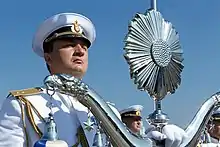 Russia, 2018.
Russia, 2018. Sweden.
Sweden.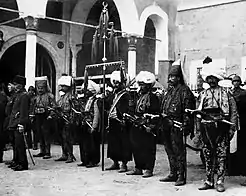 Istanbul, 1917.
Istanbul, 1917.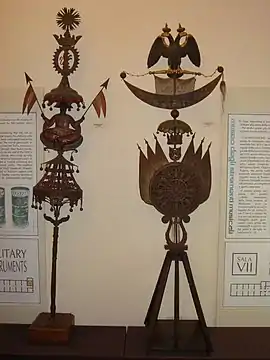 Italy.
Italy..jpg.webp) Hawaii, Royal Guards.
Hawaii, Royal Guards.
Use in specific musical works
- The Turkish crescent figures prominently in the Marche pour la Cérémonie des Turcs, part of Jean-Baptiste Lully's music for Molière's comédie-ballet Le Bourgeois gentilhomme (1670).
- The composer Wolfgang Amadeus Mozart used it in his German singspiel Die Entführung aus dem Serail (1782).
- It was used by the composer Joseph Haydn in his Symphony No. 100 (1794).
- Beethoven is said to have made use of the Jingling Johnny or Turkish crescent in the finale to his Ninth Symphony,[18][19] though it is not specified in the score.
- Hector Berlioz used it in his massive piece for military wind band with optional choir and organ Grande symphonie funèbre et triomphale (1840). His "dream ensemble" of 467 instrumentalists included four pavillons chinois among its 53 percussion instruments.[8] He said about the instrument: "The Pavillon Chinois, with its numerous little bells, serves to give brilliancy to lively pieces, and pompous marches in military music. It can only shake its sonorous locks, at somewhat lengthened intervals; that is to say, about twice in a bar, in a movement of moderate time".[20]
- John Philip Sousa's Nobles of the Mystic Shrine (1923) also called for the use of the Turkish crescent.[11]
- Gareth Gilkeson of the Rend Collective folk rock band can be seen playing a Turkish crescent in the video for the band's song "Build Your Kingdom Here" (2013).
See also
Sources
- "Mehter çalgıları" (in Turkish). Retrieved 8 December 2019.
- "çağana". Kubbealtı Lugatı (in Turkish). Kubbealtı Lugatı Akademisi. Retrieved 8 December 2019.
Türk mûsikîsinde kullanılan eski bir çalgı, çegāne (translation: An old instrument used in Turkish music, çegāne".)
- "Chaghana". Dolmetsch Music Dictionary dolmetsch.com.
Chaghana also called 'Turkish crescent', chapeau chinois or 'jingling johnnie', a ceremonial staff of ancient Central Asian origin which was adopted by the Turks ...surmounted by a crescent and a metal ornament shaped like a Chinese hat...valued by Europeans as a war trophy during periods of conflict with Turkey...
- Yarmanurl, Ozan. "ZİLLİ VE DERİ GERGİLİ ÇALGILAR" (PDF).
Çağana Acem diyarında ... pehlivan ...Batı Anadoluda benimsendiği ... Avrupa bandolarına ... geçmiş olup, "Jingling Johnnie" (Çıngırdayan Coni) veya "Turkish Crescent" (Türk Hilâli) ... ve Çin Şapkası adı da verilen ... adlarıyla anılan ve Çin Şapkası ... çıngırak başlı ve süslü uzunca bir tahta ãsã olmaktadır. (translation:Çağana Instrument...from the land of Persia...adopted in Western Anatolia...passed to European bands...known as "Jingling Johnnie" (Çıngırdayan Coni) or "Turkish Crescent" (Türk Hilâli), also known as the Chinese Hat...long wooden wooden with rattle head and ornate.
- "Turkse schelleboom van A. Maas". Retrieved 7 December 2020.
- "Chapeau chinois". Musical Instrument Museums Online, mimo-international.com.
- Chenley, Brian (September 1961). "Jingling Johnny: a Note on the Pavillon Chinois". Berlioz Society Bulletin (36): 29–30.
- Blades, James. "Turkish crescent". Grove Music Online. Oxford University Press. Retrieved 2014-06-01. (subscription required)
- Blades, James (1980). "Turkish crescent". In Stanley Sadie (ed.). The New Grove Dictionary of Music and Musicians. London: MacMillan.
- McBride, Charlie (1994-10-20). "The Fighting 88th". Galway Advertiser: 32. Retrieved 2010-12-04.
- Mellers, Wilfrid (13 Aug 1987). Music in a New Found Land: Themes and Developments in the History of American Music. Oxford University Press, USA. p. 260. ISBN 0-19-520526-X. Retrieved 2011-12-29.
...a special part is written for Turkish Crescent, an arrangement of bells supported on a mace which was carried processionally, to accompany Very Important Persons. The mace had to be twirled by a highly skilled, as well as dignified, performer. Sousa saw a possible connection between this Oriental tradition and the drum-major's twirled baton. Characteristically, the Americans democratized the ritual instrument; they christened it "Jingling Johnnie"!
- "jingling Johnny". Encyclopædia Britannica Online. 2010. Retrieved 2010-12-05.
- Blades, James (2005). Percussion Instruments and Their History. Westport, Connecticut: The Bold Strummer, Ltd. pp. 265–266, 281. ISBN 0-933224-61-3.
- Turner, Gordon; Turner, Alwyn W (June 2012). "The Band of The Coldstream Guards". military-bands.co.uk. Droit History. Archived from the original on 7 June 2008. Retrieved 16 February 2015.
- "Influence of Prussia", Honolulu Star-Bulletin, January 23, 2005 Archived June 20, 2006, at the Wayback Machine
- Mary Kawena Pukui; Samuel Hoyt Elbert (2003). "lookup of manaʻo". in Hawaiian Dictionary. Ulukau, the Hawaiian Electronic Library, University of Hawaii Press., Mary Kawena Pukui; Samuel Hoyt Elbert (2003). "lookup of hoʻomanaʻo". in Hawaiian Dictionary. Ulukau, the Hawaiian Electronic Library, University of Hawaii Press.
- Jaap Kunst. Music in Java, Its history, its theory and its technique, 3rd edition. Vol. 1. The Hague: Martinus Nijhoff. p. 184.
- "TV review: QI Jingle Bells Christmas edition" by Sam Wollaston, The Guardian, 22 December 2012
- Axworthy, Michael (2006). The Sword of Persia: Nader Shah, from Tribal Warrior to Conquering Tyrant. I.B. Tauris. p. 96. ISBN 9781850437062.
- Berlioz, Hector (1858). Tr. Mary Cowden Clarke (ed.). A Treatise Upon Modern Instrumentation and Orchestration. London: Novello, Ewer & Co. pp. 233. Retrieved 2010-12-03.
- Chappell, Mike. Wellington's Peninsula Regiments. Osprey Publishing, 2003.
External links
- Short video clip (0:25) of French Foreign Legion music with a clear shot of chapeau chinois at 0:12
- WWII (1940) video (5:13) of Legion troops departing for combat. See chapeau chinois at 0:55, 1:45, and 3:45.
- Long video (12:00) of French Foreign Legion music. Chapeau chinois is featured as an honored object from 1:06-1:30 and especially from 7:30-10:25.
- Video (2:18) of a German marching band, showing Schellenbaum as an honored object and glockenspiel as a musical instrument from 0:10-1:35.
- Video (2:31) of another German band, showing a ceremonial Schellenbaum and musical glockenspiel at 0:40 and a smaller whirling musical Schellenbaum from 0:55-1:05.
- Video (14:34) of a Chilean military parade, showing a glimpse of a ceremonial Schellenbaum from 0:50-1:00.
- History of Turkish Crescent from ancient times until the 18th century; in German: Janissary instruments and Europe
- Alla turca: Ottoman Band Influences on European Music.
- Video (3:16) of the Bundeswehr Staff Music Corps, showing Schellenbaum being assembled, used in a parade, and disassembled thereafter.